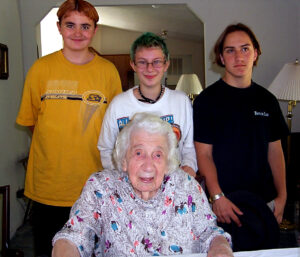We are featuring here again excerpts from the oral history project that was created 20 years ago by the students of Ryan Olson Day’s Options Class at the Mendocino Middle School. With the help of Steven Jordan and a grant obtained by Deena Zarlin, they made audio recordings of their interviews with 12 “Old Timers,” who told these children what it was like in Mendocino during the first part of the 20th century.

Kept all this time in digital form in the Kelley House Museum vault, we are publishing these stories now for the first time. We hope you enjoy this eighth installment, this time with Eleanor Atwood Smith from October 23, 2000, when she was 97 years old.
They are visiting Eleanor at her home on Little Lake Road, about four miles east of Mendocino. The interviewers are Marina Almquist Zekley, Adam Mathews, with Shawn Spiller as recording technician. Steven Jordan, a community member, is also present.
Adam starts off by asking her how and when she came to Mendocino – ship, car? Eleanor replies that she first came up on vacation from Oakland, where she and her family lived, in 1916 when she was 9 years old. “We were visiting my older brother, Henry Atwood, who worked at the Bank of Mendocino. We came by a little lumber schooner, Sea Foam, and we landed at Little River – there was a wharf there at that time – because it was too rough to land in Mendocino that day.”
When it was time for her family to return to the Bay area, she says, “Well the water was still terribly rough; and they usually took the people on and they boarded the ship with a little row boat and they couldn’t use it that day because the waves were so big they would go right into the boat. So they shipped us down like they shipped the lumber, they had a kind of a cage box for us but they did have kind of a sling rigged for taking the lumber down and we went, zoop, (LAUGHS) down and it landed on board ship, right on the deck. It didn’t take long, but it was pretty scary.”
They ask – “This is in Mendocino?” And she says, “Yes this in Mendocino right down below where Dr. Hahn’s office is for doctoring, where Dr. Gray is now. It’s just towards the ocean from that that there’s a point of land out there; and that’s where they stored lumber until it was time to ship it down.”
Marina wants to know about the one-room East Mendocino School she attended and what the teachers were like. “Well my teacher’s name was Miss Wood. Teachers? Just one! And there were about a dozen to 15 children. She taught about six grades at the time there. That was all that was there, and she did very well. It seems odd to think of that now, but you learned just as much. She took care of them very well. She put one group to study on a certain thing and another group to doing something else, writing; and she had one group come forward and sit near the teacher’s desk; and she did fine. She played the organ for the opening of the school and it was great.”
Steven asks her to tell them about the wagons with the bells. She recalls, “There were lumber camps out here in the woods where they chopped down the trees. And they had great big wagons because they hauled lots of supplies in, and tools that they need to work with, and food to run the cookhouses. And they were great big wagons that had at least four horses to pull it. And the roads were very narrow, so they put a kind of a bar across the shoulders of the horses and bells were attached to that so that about four horses had all these bells going because they wanted people to get out of the way, you know, because they were coming. People had to find a place to park so they could get by. And you could hear them for a long way, it was really it was amusing. I never actually saw the bells quite close to, but you could hear all these bells coming. That’s really before your time! That’s the way they did it. Everything had to be done by horse and buggy.”
Toward the end of these interviews, the students always ask their subjects what their hope is for Mendocino’s future. Eleanor says, “Well, I think it will be more of a tourist town than it is now. I don’t see any reason why it should go back into any other way. And many people here want to see the wildlife of the country. They wanted it to be primitive and not be so citified and not have so much population. But everybody seems to have gotten used to that now. So, for the future, I see much of the same.”
If you would like to hear these recorded voices or read this 12-page transcript in full, just give us a call at (707) 937-5791 and we’ll set you up for a visit at our research office at 45007 Albion Street in Mendocino. Our office and Museum hours are Fridays through Mondays, 11 a.m. to 3 p.m., or email us at curator@kelleyhousemuseum.org